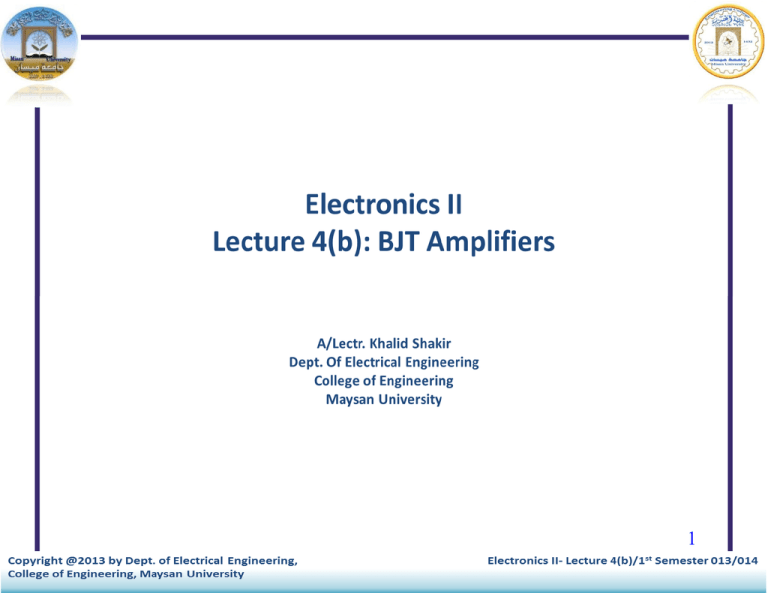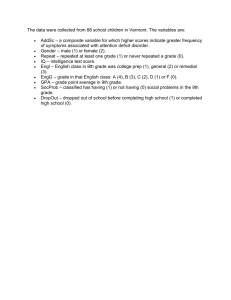Chapter 6 BJT Amplifiers
advertisement

Basic Electronic Devices and Circuits EE 111 Electrical Engineering Majmaah University 2nd Semester 1432/1433 H Chapter 6 BJT Amplifiers Electronic Devices, 9th edition Thomas L. Floyd © 2012 Pearson Education. Upper Saddle River, NJ, 07458. All rights reserved. 1 The Common-Emitter Amplifier In the common-emitter (CE) amplifier, the input signal is applied to the base and the inverted output is taken from the collector. The emitter is common to ac input & output signals. VCC RC R1 C3 Vout C1 Vin RL R2 RE Electronic Devices, 9th edition Thomas L. Floyd C2 ac short; ZC = 1/( j ω C ) [bypass capacitor] © 2012 Pearson Education. Upper Saddle River, NJ, 07458. All rights reserved. 2 AC + DC (in amplifier) 13 11 9 7 5 3 1 -1 -3 -5 = Vout AC (Vp=5V) 13 11 9 7 5 3 1 -1 -3 -5 Electronic Devices, 9th edition Thomas L. Floyd DC = 8 V (Q-point) + 13 11 9 7 5 3 1 -1 -3 -5 © 2012 Pearson Education. Upper Saddle River, NJ, 07458. All rights reserved. 3 The Common-Emitter Amplifier 8.42 2 Electronic Devices, 9th edition Thomas L. Floyd © 2012 Pearson Education. Upper Saddle River, NJ, 07458. All rights reserved. 4 DC Analysis Electronic Devices, 9th edition Thomas L. Floyd © 2012 Pearson Education. Upper Saddle River, NJ, 07458. All rights reserved. 5 The Common-Emitter Amplifier 8.42 2 Electronic Devices, 9th edition Thomas L. Floyd © 2012 Pearson Education. Upper Saddle River, NJ, 07458. All rights reserved. 6 AC Analysis Electronic Devices, 9th edition Thomas L. Floyd © 2012 Pearson Education. Upper Saddle River, NJ, 07458. All rights reserved. 7 Signal (AC) Voltage at the Base Electronic Devices, 9th edition Thomas L. Floyd © 2012 Pearson Education. Upper Saddle River, NJ, 07458. All rights reserved. 8 Input Resistance at the Base Electronic Devices, 9th edition Thomas L. Floyd © 2012 Pearson Education. Upper Saddle River, NJ, 07458. All rights reserved. 9 Output Resistance The output resistance is the resistance seen looking back into the output terminal with Vin=0. (re' is much smaller than rc' ) (rc' is much larger than RC ) Electronic Devices, 9th edition Thomas L. Floyd © 2012 Pearson Education. Upper Saddle River, NJ, 07458. All rights reserved. 10 Why find Input Resistance? Supply Amplifier Voltage division. We prefer high Rin(tot) Electronic Devices, 9th edition Thomas L. Floyd Why find Output Resistance? Amplifier Load Voltage division. We prefer low Rout © 2012 Pearson Education. Upper Saddle River, NJ, 07458. All rights reserved. 11 The Common-Emitter Amplifier This figure is mentioned in the next slide. 8.42 2 Electronic Devices, 9th edition Thomas L. Floyd © 2012 Pearson Education. Upper Saddle River, NJ, 07458. All rights reserved. 12 (actually 3.58 mA on slide 18, but use 3.8 mA) < 10 mV ! There is significant attenuation (reduction) of the source (supply) voltage due to the voltage division between the source resistance (Rs) and the amplifier’s input resistance (Rin(tot)). Electronic Devices, 9th edition Thomas L. Floyd © 2012 Pearson Education. Upper Saddle River, NJ, 07458. All rights reserved. 13 The Common-Emitter Amplifier 8.42 2 Electronic Devices, 9th edition Thomas L. Floyd © 2012 Pearson Education. Upper Saddle River, NJ, 07458. All rights reserved. 14 Voltage Gain This is the voltage gain from base to collector. To get the overall gain of the amplifier from the supply voltage to collector, the attenuation of the input circuit must be included. Electronic Devices, 9th edition Thomas L. Floyd © 2012 Pearson Education. Upper Saddle River, NJ, 07458. All rights reserved. 15 Attenuation Attenuation is the reduction in signal voltage as it passes through a circuit and corresponds to a gain of less than 1. gain = 1 / attenuation gain = output / input attenuation = 1 / gain = input / output Example: If the signal amplitude is reduced by half, gain = 0.5 or attenuation = 1 / 0.5 = 2 Example: A source (supply) produces a 10 mV input signal, and the source resistance combined with the load resistance results in a 2 mV output signal. gain = output / input = 2 / 10 = 0.2 attenuation = input / output = 10 / 2 = 5 Electronic Devices, 9th edition Thomas L. Floyd © 2012 Pearson Education. Upper Saddle River, NJ, 07458. All rights reserved. 16 Overall Voltage Gain Voltage gain from base to collector = Av = Vc / Vb Attenuation from source (supply) to base = Vs / Vb (reciprocal of voltage division) The overall voltage gain of the amplifier, is the voltage gain from base to collector, Vc / Vb, times the reciprocal of the attenuation, Vb / Vs. ≥1 Electronic Devices, 9th edition Thomas L. Floyd <1 ≥1 © 2012 Pearson Education. Upper Saddle River, NJ, 07458. All rights reserved. 17


